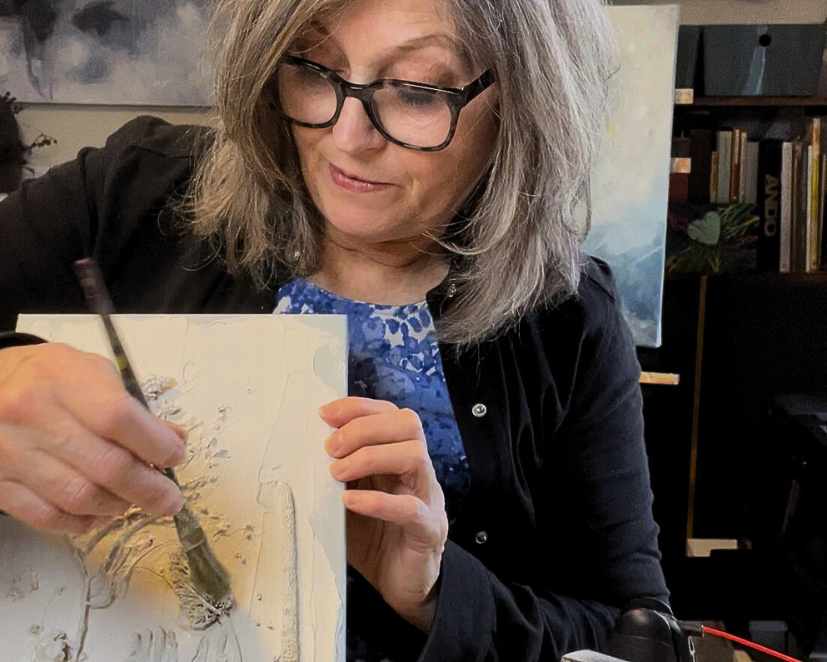Botanical plaster art is having a moment; people love organic art that incorporates an aesthetically preserved moment in the life process of our natural world. But what do you do with the accumulated dust a few months into displaying your dimensional plaster art? The pressing question is, how to clean plaster art?
The endless struggle between dust and us becomes a how-to-head-scratcher when discussing plaster art.
Plaster is a delicate surface, and natural botanicals stuck onto its surface are equally so. These botanicals are stunning in their natural symmetrical and ordered stamens, pistils, leaves, blades, and seed heads forever suspended in time, hanging on your wall, or framed, sitting on a desktop.
Plaster is one of the oldest painting supports, applied initially to walls for fresco paintings. Over time, our love of texture has incorporated plaster as a key visual component of some artwork, and today, artists use traditional plaster, heavy body acrylics, and even drywall compounds in their recipes to create exciting and unique art.
However, the edges are so delicate that regular dusting techniques can disengage parts of them permanently.
What to use to clean or dust plaster and plaster botanical art:
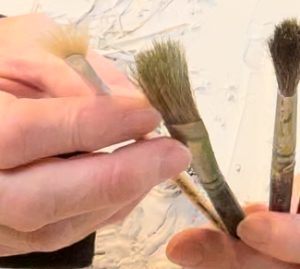
- You can use a soft-bristled artist brush to clean or dust plaster art or botanical art. A small-headed brush with long bristles allows for a more open movement that will not push off the delicate tips of plant pistils or seed heads. An artist’s small-headed fan brush will also work.
- The fewer the bristles on the brush, the softer the dusting movement.
What should NOT be used to clean plaster art:
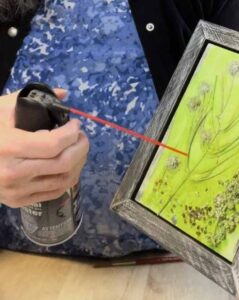
- A can of pressurized air. I wondered if this could be a hands-off way to combat dust, so I purchased a can and tried it. The air comes out too strongly to control what it dislodges. Increasing the distance between the art and the can of air does help, but it remains a reckless and not easily controlled choice.
- Water. Mostly, plaster remains porous. Although some artists will apply a protective plastic layer to seal the surface, keeping wetness away from plaster and botanicals is a good practice. If you know it has been painted over with acrylic (plastic) paint or a sealer, a light touch with soap and water and a soft brush as described above can be used.
- A cloth. Probably self-explanatory, a cloth has far too much abrasion power.
- A makeup brush. Although your makeup brush may be soft, its filaments (hairs) are likely too densely arranged and, therefore, not good at gently brushing dust off delicately stemmed botanicals. However, a small-headed and openly arranged makeup fan-type brush might be an option.
How to repair a piece that breaks off a plaster artwork:
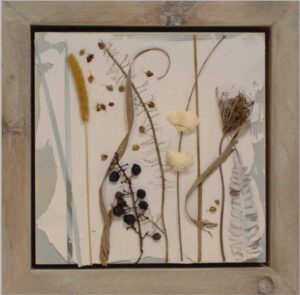
Often, a plaster botanical artwork, so fresh and different from traditional paintings, is hung in a place of prominence where guests can easily view it. However, this can mean it is more likely to be accidentally knocked or brushed against.
- If a piece of natural plant or a part of plaster is broken off, it can usually be easily fixed. Use a simple liquid glue to restore a broken part onto the surface.
- Some glues remain white when they dry, so choose a glue that will dry clear or keep it only underneath the piece. Remember that most glues dry with a sheen, so focus the glue where it won’t be seen.
- If you have sewing pins, gently pierce the broken part into the plaster to hold it in place while the glue dries. Alternatively, a length of painter’s tape is gentle enough and pretty good at holding the piece down securely on either side while the glue dries.
Be still our wild plaster botanical hearts.

- Imagine beautiful, modern, 100% natural plaster art. Delicate natural botanicals suspended in raw plaster can now be shaken up in a contemporary way for a modern home. See Jade’s plaster art pieces for sale.
- Botanicals can be elegantly covered in simple white plaster, pressed traditionally into plaster (called plaster reliefs), or last season’s dried wild flora mounted atop plaster backgrounds. These plaster fields (backgrounds) are usually white but sometimes are tinted, painted on, or smudged haphazardly and artistically over wood panels.
- Frames of white-washed or natural craggy wood add to these textural pieces. If you purchase an art piece from Jade, artistic frames provide decorative variety for art lovers and designers. Other plaster botanicals are displayed un-framed on 1 1/2″ gallery depth canvases.
Botanical plaster art reminds us of our connection to the innocence of wild plants, butterflies, and childhood.
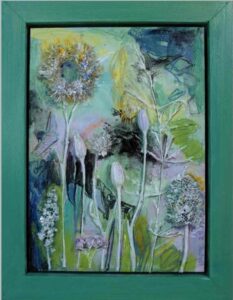
Art that evokes emotions, especially beautiful ones, is always welcome.
Botanical plaster art makes us feel lovely, encouraging us to remember the gentle moments when we are amongst wildflowers or native wild plants. We often share these moments with the people we love, even butterflies and insects that are also drawn to them.
As a child, my wild bouquets were often scratchy little ditch flowers; my mom and dad set my bunches of weeds in a little vase where our dog’s wagging tail could not pick up the burrs.
Would you like to buy a gift created with wild flora to remind someone or yourself of a walk through a beloved place or to invoke pleasant memories? Contact Jade for a custom piece, or visit my Buy Art page (plasters).

